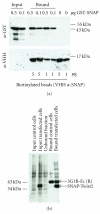The availability of a recombinant anti-SNAP antibody in VHH format amplifies the application flexibility of SNAP-tagged proteins
- PMID: 20981296
- PMCID: PMC2963136
- DOI: 10.1155/2010/658954
The availability of a recombinant anti-SNAP antibody in VHH format amplifies the application flexibility of SNAP-tagged proteins
Abstract
Antibodies are indispensable reagents in basic research, and those raised against tags constitute a useful tool for the evaluation of the biochemistry and biology of novel proteins. In this paper, we describe the isolation and characterization of a single-domain recombinant antibody (VHH) specific for the SNAP-tag, using Twist2 as a test-protein. The antibody was efficient in western blot, immunoprecipitation, immunopurification, and immunofluorescence. The sequence corresponding to the anti-SNAP has been subcloned for large-scale expression in vectors that allow its fusion to either a 6xHis-tag or the Fc domain of rabbit IgG2 taking advantage of a new plasmid that was specifically designed for VHH antibodies. The two different fusion antibodies were compared in immunopurification and immunofluorescence experiments, and the recombinant protein SNAP-Twist2 was accurately identified by the anti-SNAP Fc-VHH construct in the nuclear/nucleolar subcellular compartment. Furthermore, such localization was confirmed by direct Twist2 identification by means of anti-Twisit2 VHH antibodies recovered after panning of the same naïve phage display library used to isolate the anti-SNAP binders. Our successful localization of Twist2 protein using the SNAP-tag-based approach and the anti-Twist2-specific recombinant single-domain antibodies opens new research possibilities in this field.
Figures




References
-
- Keppler A, Kindermann M, Gendreizig S, Pick H, Vogel H, Johnsson K. Labeling of fusion proteins of O6-alkylguanine-DNA alkyltransferase with small molecules in vivo and in vitro. Methods. 2004;32(4):437–444. - PubMed
-
- Kampmeier F, Ribbert M, Nachreiner T, et al. Site-specific, covalent labeling of recombinant antibody fragments via fusion to an engineered version of 6-O-alkylguanine DNA alkyltransferase. Bioconjugate Chemistry. 2009;20(5):1010–1015. - PubMed
-
- Gronemeyer T, Chidley C, Juillerat A, Heinis C, Johnsson K. Directed evolution of O6-alkylguanine-DNA alkyltransferase for applications in protein labeling. Protein Engineering, Design and Selection. 2006;19(7):309–316. - PubMed
-
- Juillerat A, Heinis C, Sielaff I, et al. Engineering substrate specificity of O6-alkylguanine-DNA alkyltransferase for specific protein labeling in living cells. ChemBioChem. 2005;6(7):1263–1269. - PubMed
-
- Maurel D, Banala S, Laroche T, Johnsson K. Photoactivable and photocnvertible fluorescent probes for protein labeling. ACS Chemical Biology. 2010;5:507–516. - PubMed
Publication types
MeSH terms
Substances
LinkOut - more resources
Full Text Sources
Other Literature Sources
Molecular Biology Databases

